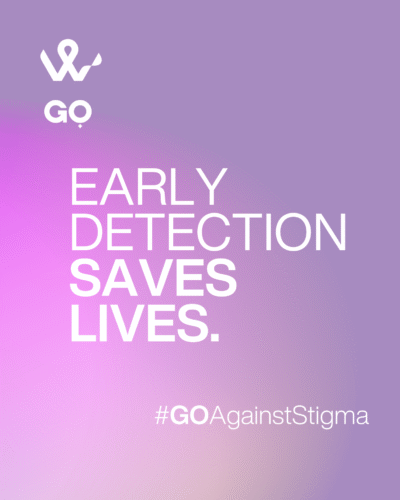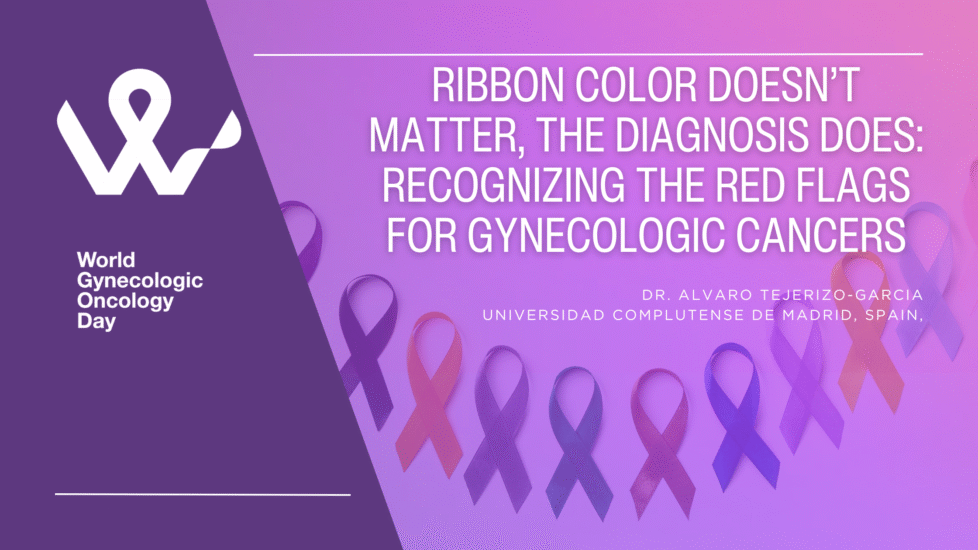
By Dr. Alvaro Tejerizo-Garcia, Universidad Complutense de Madrid, Spain.
(With thanks to Laura Liz Lambdin for suggesting this topic at our July 7 meetup! If you have a topic to suggest, please get in touch at worldgoday@esgo.org) Note: Dr. Alvaro Tejerizo-Garcia is a Council Member of the European Society of Gynaecological Oncology (ESGO) and the newest member of the World Gynecologic Oncology Day Working group. We’re glad to have him!
In a world increasingly defined by color-coded ribbons and themed awareness months, it’s easy to associate a specific hue with a cause without going deeper. Teal for ovarian. Peach for uterine. Et cetera. But when it comes to gynecologic cancers—cancers that affect the reproductive organs—it’s not the color that saves lives, it’s awareness, education, and timely diagnosis.
Information is power, but communication is the solution. By providing more information about the causes of these cancers we hope to lift the burden of stigma linked to gynecologic cancers in society and to contribute to a more open and non-censored communication in the public space.
Whether it’s teal, peach, purple, or another shade altogether, let’s not get lost in the colors. Instead, let’s focus on the symptoms, risk factors, and red flags of the five primary types of gynecologic cancers: ovarian, uterine (also known as endometrial or womb), cervical, vulvar, and vaginal cancer. Understanding the signs can be the difference between early detection and a missed opportunity for timely treatment. Take a look at our list below to help you keep the colors—and the symptoms—straight.
The list also notes the most common gynecologic cancer awareness days and months. There seem to be more and more such events, indicating more awareness around the world. World Gynecologic Oncology Day takes place on September 20, chosen because September is Gynecologic Cancer Awareness Month. ENGAGe created our event in 2019 to connect advocates and expand the focus from single cancer types to all of the gynecologic cancers, their symptoms, and possible prevention.
Note that in September we also communicate about rare cancers that may not have an established awareness event,
Cervical Cancer
Color: Fuchsia pink in some regions, teal in others
Awareness Events: World Cervical Cancer Elimination Day – November 17
Cervical Cancer Awareness Month—January
Cervical Cancer Prevention Week—the third week in January
HPV Awareness Day –March 4
Fuchsia pink or teal represents cervical cancer awareness. With the advent of HPV vaccines, regular cervical screening (Pap smears) and HPV DNA tests, cervical cancer is one of the most preventable forms of cancer—yet it continues to take lives worldwide, especially in underserved regions.
Red Flags to Watch For:
- Abnormal vaginal bleeding (between periods, after sex, or after menopause)
- Pelvic pain or pain during intercourse
- Watery or bloody vaginal discharge that smells bad
Why It Matters:
Vaccination is the most effective tool we have to prevent cervical cancer. However, even with proper vaccination, regular screening with cervical cytology and HPV testing remains essential, as it allows us to detect precancerous lesions—sometimes years before they become cancerous.
It is crucial to undergo screening regularly, since a single negative result does not rule out the presence of an underlying lesion.

Ovarian Cancer
Color: Teal
Awareness Event: World Ovarian Cancer Day –May 8
Ovarian Cancer Awareness Month—March (UK), September (USA)
Teal represents ovarian cancer—a color symbolizing clarity and healing. But ovarian cancer is anything but clear in its early stages, often called the “silent killer” because its symptoms are vague and easily mistaken for common issues.
Red Flags to Watch For:
- Persistent bloating
- Pelvic or abdominal pain (new and persistent)
- Difficulty eating or feeling full quickly
- Urinary urgency or frequency
Why It Matters:
There is no reliable screening test for ovarian cancer. Awareness of subtle, persistent symptoms is critical. These symptoms are sometimes mistaken for digestive issues, which may lead to delays in the diagnosis and treatment of ovarian cancer.
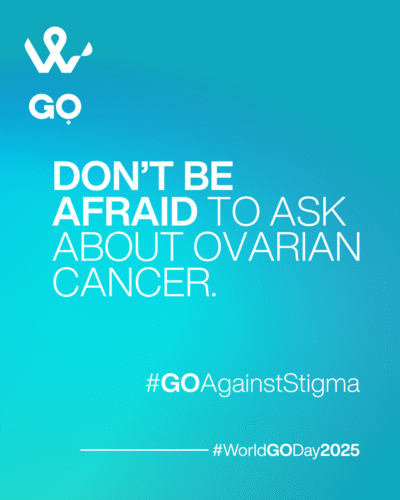
Uterine (Endometrial/Womb) Cancer
Color: Peach
Awareness Event: Uterine Cancer Awareness Month – June
Peach may feel soft and gentle, but uterine cancer—particularly endometrial cancer—demands serious attention. It’s the most common gynecologic cancer in the world, yet many women dismiss its most common symptoms.
Red Flags to Watch For:
- Abnormal uterine bleeding (especially after menopause)
- Pelvic pain or pressure
- Unusual discharge
Why It Matters:
Endometrial cancer is often caught early because of abnormal bleeding. But it’s often misattributed to perimenopause or other benign conditions—raising the importance of not ignoring any changes. Unfortunately, endometrial cancer is increasingly being diagnosed in women of reproductive age, which can make timely diagnosis more challenging. That’s why it’s essential to seek medical advice in the case of persistent abnormal genital bleeding.

Vulvar Cancer
Color: Light purple
Awareness Event: Vulvar Cancer Awareness Month – February, September
Vulvar Awareness Day – September 18
Light purple signals a cancer rarely spoken of—vulvar cancer. Often underdiagnosed due to stigma or lack of awareness, this cancer affects the external genitalia, mostly in older women.
Red Flags to Watch For:
- Itching, burning, or tenderness in the vulva
- Changes in vulvar skin (color, thickness, lumps, ulcers or persistent sores that do not heal)
- Pain during urination or sex
Why It Matters:
Early diagnosis is essential, as it allows for the detection of precancerous lesions and, in cases of malignancy, enables less aggressive treatment options. Any persistent lesion that does not improve with treatment should be assessed by a healthcare professional. It is not uncommon for patients to attribute such symptoms to irritation or infections caused by prolonged moisture in the area, which may unfortunately delay diagnosis.
Vaginal Cancer
Color: Blue
Awareness Month: Gynecologic Cancer Awareness Month – September
(There is no dedicated global day yet but this cancer is often grouped within broader gynecologic cancer awareness efforts.)
Represented by blue, vaginal cancer is rare, but when it does occur, it often stems from HPV infection. Like cervical cancer, it’s linked to a virus that can be prevented.
Red Flags to Watch For:
- Abnormal vaginal bleeding (between periods, after sex ) or discharge
- Pain during intercourse
- A lump or mass in the vagina
- Painful urination
Why It Matters:
Because it’s rare, symptoms are often missed or mistaken for less serious issues. HPV vaccination plays a key role in prevention. As with cervical cancer, regular screening—including examination of the vaginal area—can help detect precancerous lesions and may reduce the need for more aggressive treatments.
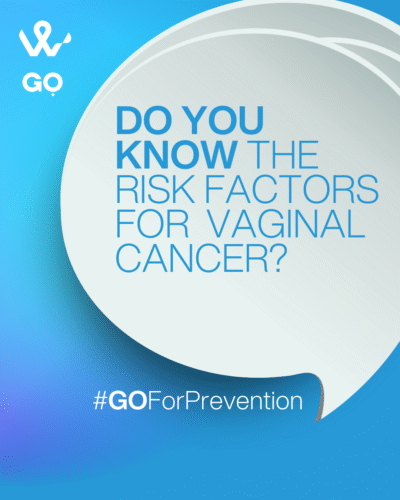
Don’t Be Misled by the Color—Pay Attention to the Symptoms
It’s almost September, Gynecologic Cancer Awareness Month (represented by purple), and just a month to go until World Gynecologic Oncology Day 2025 (note our multi-colored ribbon of peach, teal, purple, fuchsia and blue).
These awareness colors serve an important purpose: rallying communities, fundraising for research, and breaking silence around stigmatized diseases. But colors alone don’t diagnose or save lives—knowledge does. It’s time to talk openly about the full spectrum of gynecologic cancers and emphasize symptom awareness.
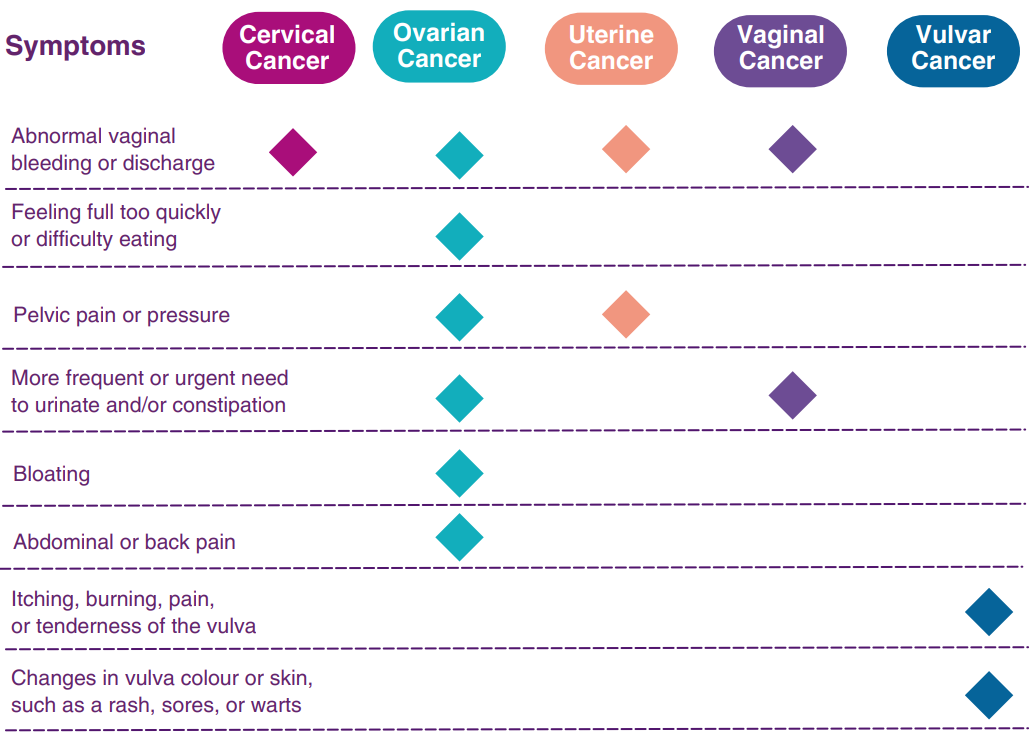
A table of the most common gynecologic cancer symptoms, prepared by the Irish Network for Gynaecological Oncology (INGO)




